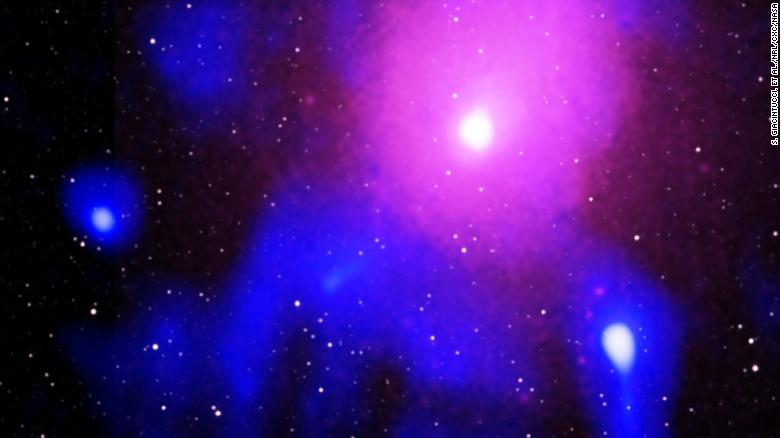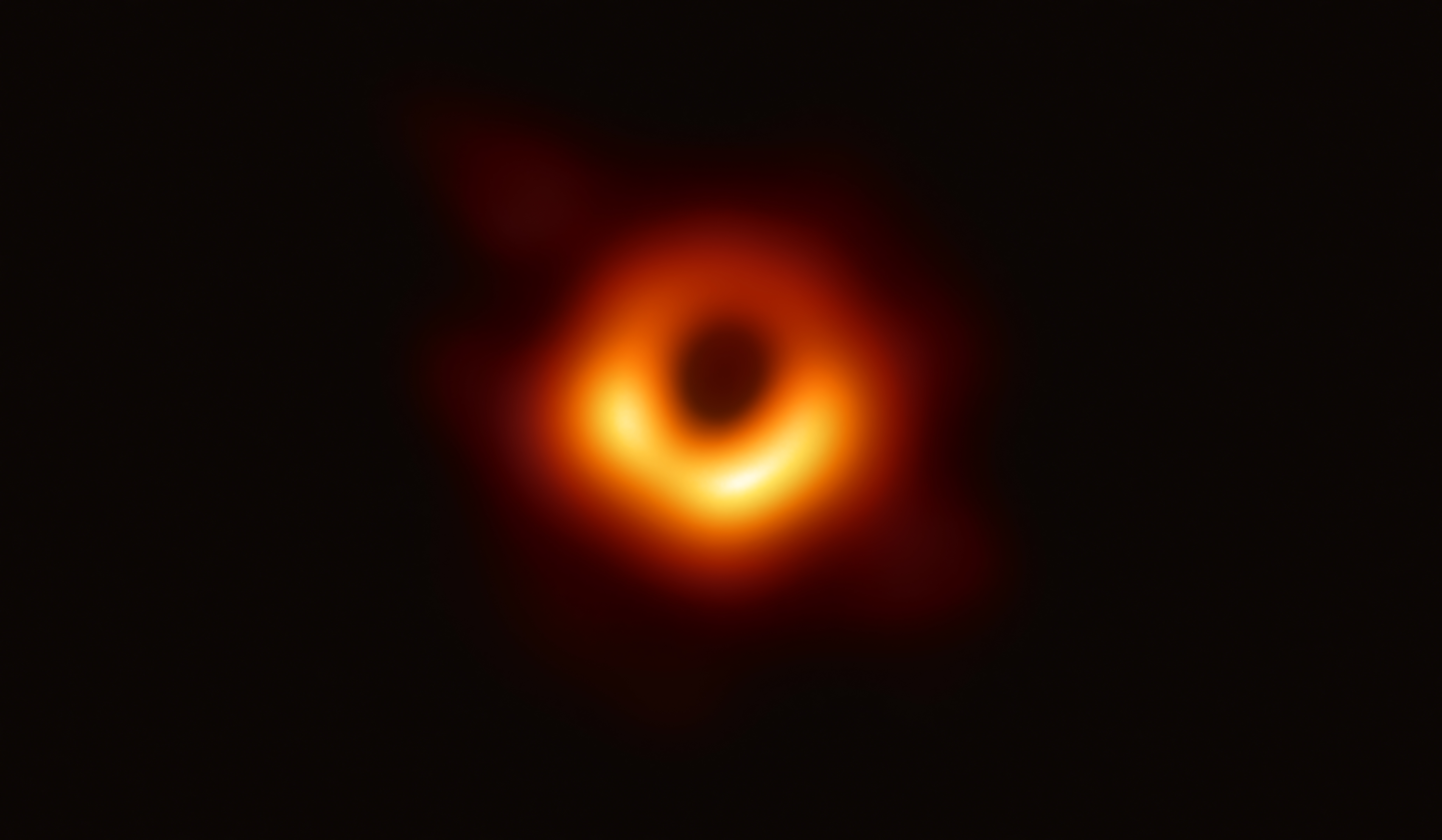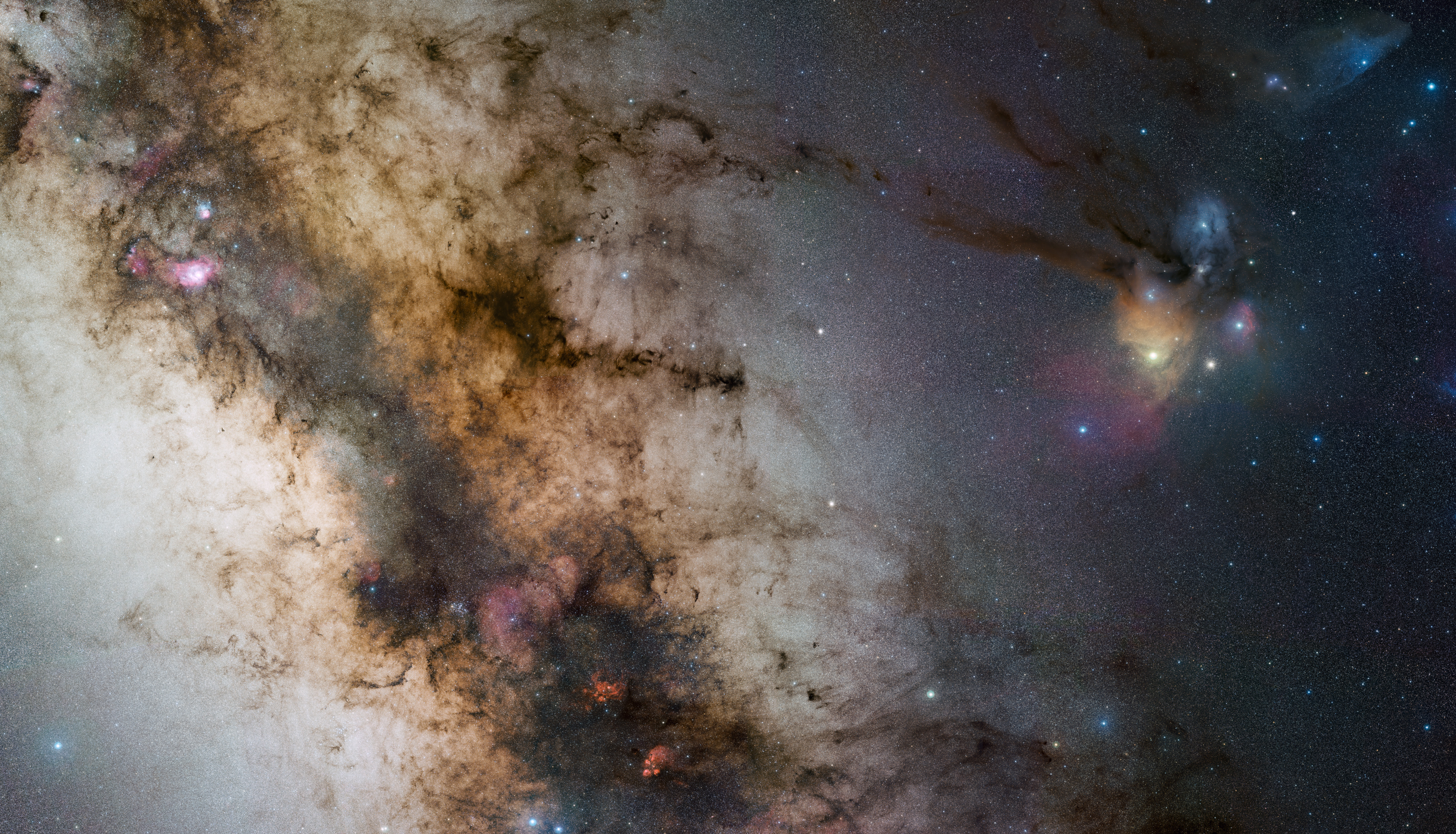|
NeVe 1
NeVe 1 is a supergiant elliptical galaxy, which is the central, dominant member and brightest cluster galaxy (BCG) of the Ophiuchus Cluster. It lies at a distance of about 411 million light-years away from Earth and is located behind the Zone of Avoidance region in the sky. It is the host galaxy of the Ophiuchus Supercluster eruption, the most energetic astronomical event known. Observation history Despite being in the relatively nearby, large Ophiuchus Cluster, due to its location behind the Milky Way galactic disc relative to the Earth's perspective (known as the Zone of Avoidance), the majority of the cluster including NeVe 1 are heavily obscured and invisible to the naked eye, such that it can only be observed in wavelengths beyond the visible spectrum, such as X-rays and infrared. When first observed in 1985 it was initially thought to be a planetary nebula within the large, star-forming Rho Ophiuchi cloud complex. In a catalogue published by the German astronomers ... [...More Info...] [...Related Items...] OR: [Wikipedia] [Google] [Baidu] |
Infrared
Infrared (IR; sometimes called infrared light) is electromagnetic radiation (EMR) with wavelengths longer than that of visible light but shorter than microwaves. The infrared spectral band begins with the waves that are just longer than those of red light (the longest waves in the visible spectrum), so IR is invisible to the human eye. IR is generally (according to ISO, CIE) understood to include wavelengths from around to . IR is commonly divided between longer-wavelength thermal IR, emitted from terrestrial sources, and shorter-wavelength IR or near-IR, part of the solar spectrum. Longer IR wavelengths (30–100 μm) are sometimes included as part of the terahertz radiation band. Almost all black-body radiation from objects near room temperature is in the IR band. As a form of EMR, IR carries energy and momentum, exerts radiation pressure, and has properties corresponding to both those of a wave and of a particle, the photon. It was long known that fires e ... [...More Info...] [...Related Items...] OR: [Wikipedia] [Google] [Baidu] |
Kelvin–Helmholtz Instability
The Kelvin–Helmholtz instability (after Lord Kelvin and Hermann von Helmholtz) is a fluid instability that occurs when there is shear velocity, velocity shear in a single continuum mechanics, continuous fluid or a velocity difference across the interface between two fluids. Kelvin-Helmholtz instabilities are visible in the atmospheres of planets and moons, such as in List of cloud types, cloud formations on Earth or the Great Red Spot#Great Red Spot, Red Spot on Jupiter, and the Stellar atmosphere, atmospheres of the Sun and other stars. Theory overview and mathematical concepts Fluid dynamics predicts the onset of instability and transition to turbulent flow within fluids of different density, densities moving at different speeds. If surface tension is ignored, two fluids in parallel motion with different velocities and densities yield an interface that is unstable to short-wavelength perturbations for all speeds. However, surface tension is able to stabilize the short w ... [...More Info...] [...Related Items...] OR: [Wikipedia] [Google] [Baidu] |
Supermassive Black Hole
A supermassive black hole (SMBH or sometimes SBH) is the largest type of black hole, with its mass being on the order of hundreds of thousands, or millions to billions, of times the mass of the Sun (). Black holes are a class of astronomical objects that have undergone gravitational collapse, leaving behind spheroidal regions of space from which nothing can escape, including light. Observational evidence indicates that almost every large galaxy has a supermassive black hole at its center. For example, the Milky Way galaxy has a supermassive black hole at its center, corresponding to the radio source Sagittarius A*. Accretion of interstellar gas onto supermassive black holes is the process responsible for powering active galactic nuclei (AGNs) and quasars. Two supermassive black holes have been directly imaged by the Event Horizon Telescope: the black hole in the giant elliptical galaxy Messier 87 and the black hole at the Milky Way's center (Sagittarius A*). Descr ... [...More Info...] [...Related Items...] OR: [Wikipedia] [Google] [Baidu] |
Gamma-ray Burst
In gamma-ray astronomy, gamma-ray bursts (GRBs) are extremely energetic events occurring in distant Galaxy, galaxies which represent the brightest and most powerful class of explosion in the universe. These extreme Electromagnetic radiation, electromagnetic emissions are second only to the Big Bang as the most energetic and luminous phenomenon ever known. Gamma-ray bursts can last from a few milliseconds to several hours. After the initial flash of gamma rays, a longer-lived afterglow is emitted, usually in the longer wavelengths of X-ray, ultraviolet, visible spectrum, optical, infrared, microwave or radio waves, radio frequencies. The intense radiation of most observed GRBs is thought to be released during a supernova or superluminous supernova as a high-mass star implodes to form a neutron star or a black hole. Short-duration (sGRB) events are a subclass of GRB signals that are now known to originate from the cataclysmic Neutron star merger, merger of binary neutron stars. Th ... [...More Info...] [...Related Items...] OR: [Wikipedia] [Google] [Baidu] |
GRB 221009A
GRB 221009A was an extraordinarily bright and very energetic gamma-ray burst (GRB) jointly discovered by the Neil Gehrels Swift Observatory and the Fermi Gamma-ray Space Telescope on October 9, 2022. The gamma-ray burst was ten minutes long, but was detectable for more than ten hours following initial detection. Despite being around 2.4 billion light-years away, it was powerful enough to affect Earth's atmosphere, having the strongest effect ever recorded by a gamma-ray burst on the planet. The peak luminosity of GRB 221009A was measured by Konus-Wind to be ~ 2.1 × 1047 W and by Fermi Gamma-ray Burst Monitor to be ~ 1.0 × 1047 W over its 1.024s interval. A burst as energetic and as close to Earth as 221009A is thought to be a once-in-10,000-year event. It was the brightest and most energetic gamma-ray burst ever recorded, with some dubbing it the BOAT, or Brightest Of All Time. Characterization GRB 221009A came from the constellation of Sagitta and occurred an estimated 1.9 ... [...More Info...] [...Related Items...] OR: [Wikipedia] [Google] [Baidu] |
MS 0735
MS 0735.6+7421 is a galaxy cluster located in the constellation Camelopardalis, approximately 2.6 billion light-years away. It is notable as the location of one of the largest central galactic black holes in the known universe, which has also apparently produced one of the most powerful active galactic nucleus eruptions discovered. In February 2020, it was reported that another similar but much more energetic AGN outburst - the Ophiuchus Supercluster eruption in the NeVe 1 galaxy, was five times the energy of MS 0735.6+7421. Black hole eruption Using data from the Chandra X-ray Observatory, scientists have deduced that an eruption has been occurring for the last 100 million years at the heart of the galaxy cluster, releasing as much energy over this time as hundreds of millions of gamma ray bursts. (The amount of energy released in a year is thus equivalent to several GRBs.) The remnants of the eruption are seen as two cavities on either side of a large central galaxy. If thi ... [...More Info...] [...Related Items...] OR: [Wikipedia] [Google] [Baidu] |
Ophiuchus Galaxy Cluster Labelled
Ophiuchus () is a large constellation straddling the celestial equator. Its name comes from the Ancient Greek (), meaning "serpent-bearer", and it is commonly represented as a man grasping a snake. The serpent is represented by the constellation Serpens. Ophiuchus was one of the 48 constellations listed by the 2nd-century astronomer Ptolemy, and it remains one of the 88 modern constellations. An old alternative name for the constellation was Serpentarius. Location Ophiuchus lies between Aquila, Serpens, Scorpius, Sagittarius, and Hercules, northwest of the center of the Milky Way. The southern part lies between Scorpius to the west and Sagittarius to the east. In the northern hemisphere, it is best visible in summer. It is opposite of Orion. Ophiuchus is depicted as a man grasping a serpent; the interposition of his body divides the snake constellation Serpens into two parts, Serpens Caput and Serpens Cauda. Ophiuchus straddles the equator with the majority of ... [...More Info...] [...Related Items...] OR: [Wikipedia] [Google] [Baidu] |
Cooling Flow
A cooling flow occurs when the intracluster medium (ICM) in the centres of galaxy clusters should be rapidly cooling at the rate of tens to thousands of solar masses per year. This should happen as the ICM (a plasma) is quickly losing its energy by the emission of X-rays. The X-ray brightness of the ICM is proportional to the square of its density, which rises steeply towards the centres of many clusters. Also the temperature falls to typically a third or a half of the temperature in the outskirts of the cluster. The typical redictedtimescale for the ICM to cool is relatively short, less than a billion years. As material in the centre of the cluster ''cools out'', the pressure of the overlying ICM should cause more material to flow inwards (the cooling flow). In a steady state, the rate of ''mass deposition'', i.e. the rate at which the plasma cools, is given by : \dot = \frac \frac, where ''L'' is the bolometric (i.e. over the entire spectrum) luminosity of the cooling region, ... [...More Info...] [...Related Items...] OR: [Wikipedia] [Google] [Baidu] |
Chandra X-ray Observatory
The Chandra X-ray Observatory (CXO), previously known as the Advanced X-ray Astrophysics Facility (AXAF), is a Flagship-class space telescope launched aboard the during STS-93 by NASA on July 23, 1999. Chandra is sensitive to X-ray sources 100 times fainter than any previous X-ray telescope, enabled by the high angular resolution of its mirrors. Since the Earth's atmosphere absorbs the vast majority of X-rays, they are not detectable from Earth-based telescopes; therefore space-based telescopes are required to make these observations. Chandra is an Earth satellite in a 64-hour orbit, and its mission is ongoing . Chandra is one of the Great Observatories, along with the Hubble Space Telescope, Compton Gamma Ray Observatory (1991–2000), and the Spitzer Space Telescope (2003–2020). The telescope is named after the Nobel Prize-winning Indian-American astrophysicist Subrahmanyan Chandrasekhar. Its mission is similar to that of ESA's XMM-Newton spacecraft, also launched in ... [...More Info...] [...Related Items...] OR: [Wikipedia] [Google] [Baidu] |
Messier 87
Messier 87 (also known as Virgo A or NGC 4486, generally abbreviated to M87) is a Type-cD galaxy, supergiant elliptical galaxy, elliptical galaxy in the constellation Virgo (constellation), Virgo that contains several trillion stars. One of the List of largest galaxies, largest and most massive galaxies in the local universe, it has a large population of globular clusters—about 15,000 compared with the 150–200 orbiting the Milky Way—and a jet of energetic plasma (physics), plasma that originates at the core and extends at least , traveling at a relativistic speed. It is one of the brightest radio sources in the sky and a popular target for both amateur and professional astronomers. The French astronomer Charles Messier discovered M87 in 1781, and cataloged it as a nebula. M87 is about from Earth and is the second-brightest galaxy within the northern Virgo Cluster, having many satellite galaxies. Unlike a disk-shaped spiral galaxy, M87 has no distinctive du ... [...More Info...] [...Related Items...] OR: [Wikipedia] [Google] [Baidu] |
Active Galactic Nucleus
An active galactic nucleus (AGN) is a compact region at the center of a galaxy that emits a significant amount of energy across the electromagnetic spectrum, with characteristics indicating that this luminosity is not produced by the stars. Such excess, non-stellar emissions have been observed in the radio waves, radio, microwave, infrared, visible spectrum, optical, ultra-violet, X-ray and gamma ray wavebands. A galaxy hosting an AGN is called an active galaxy. The non-stellar radiation from an AGN is theorized to result from the accretion (astrophysics), accretion of matter by a supermassive black hole at the center of its host galaxy. Active galactic nuclei are the most luminous persistent sources of electromagnetic radiation in the universe and, as such, can be used as a means of discovering distant objects; their evolution as a function of cosmic time also puts constraints on cosmology, models of the cosmos. The observed characteristics of an AGN depend on several properties s ... [...More Info...] [...Related Items...] OR: [Wikipedia] [Google] [Baidu] |










